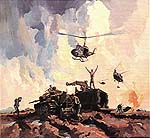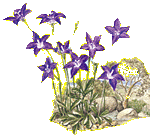Tracks Magazine - August 1955


A couple of decades ago I was travelling through northern NSW and called in to see Archie McDonald, an old 1 Armoured Regiment LAD mate. Archie had kept his copy of the first issue of the Regiment's glossy magazine, Tracks — August 1955. It is this magazine that is re-produced below
Tracks Magazine
Index
Foreword Preface Principles of Employment of Armour Keep An Open Mind Review of Squadron Activities Regimental Headquarters Headquarters Squadron Reconnaissance Troop A Squadron Notes B Squadron Notes Nucleus Squadron Regimental Training Troop Light Aid Detachment, RAEME Signals Troop, RASigsIndex (cont)
Review of Allied Armour Tanks in The Jungle Korean Sidelights Equipments 1954 .. A Royal Occasion On Parade Elevating Gear Officers' Mess Notes Sergeants' Mess Notes In The Realm of Sport It Could be You The Adjutant's Dilemma While Others Sleep [et al] Beauchamps Own Epilogue Free Verse From A Free Thinker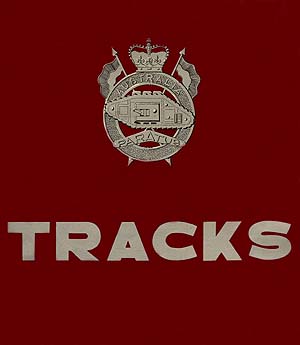

"Tracks To Tradition"A REGIMENTAL HISTORY
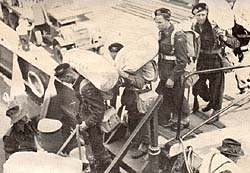

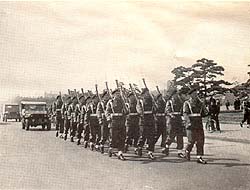


Recently the Regiment underwent a major reorganization involving the addition of C Squadron and the reduction in size of Sabre Squadrons. This is by no means the first reorganization that has occurred within the Regiment and, as this is the first issue of our Journal, a few words about our Regimental history seems appropriate.
This history commences with our birthday on the 21 st January, 1946, as it was on that day that the First Australian Armoured Car Squadron was formed in Puckapunyal for service in Occupation Forces in Japan. The Squadron was formed by Major C. Ives (now Lt Col. Ives, C.O. of the Apprentices' School) and was equipped with Staghound Armoured Cars and Canadian Scout Cars (better known as Doodlebugs). The Squadron sailed from Sydney late in March and arrived in Kure on the 12th of April, 1946.
During the later stages of World War II the Fourth Armoured Brigade was stationed in Southern Queensland and served as the parent formation for a number of Armoured Units, some of which saw service in the Islands. It was from this Brigade that the original volunteers came to form the Armoured Car Squadron. We have, therefore, a direct link with the once large and proud Armoured Corps that was raised during the war.
During the period that the Squadron was in Japan it performed normal occupational duties, which included guards on the Imperial Palace in Tokyo and extensive patrolling of the Island of Skikohu, mainly to let the Japanese know that there was an Occupation Force.
The Squadron was stationed initially at Kaitaichi and later moved to semi-permanent barracks at Hiro, near Kure. On the 18th of December, 1948, the Unit finally embarked at Kure for return to Australia, where it was again stationed at Puckapunyal.
On the 7th of July, 1949, the Squadron was renamed the First Armoured Regiment, and at about the same time we were equipped with Churchill tanks. We were still, however, only a Regiment in name, as our strength was that of a very underposted Squadron and no Regimental Headquarters had been raised. The next three years were very lean ones and amounted to a struggle for existence, as those who were with the Regiment at the time will tell you.
One important episode was the publication of our alliance with the Royal Tank Regiment, which was made effective from the 30th June, 1951. We should be proud of our alliance with this fine Regiment, and we must make sure, by our efforts, that the Royal Tank Regiment shares that pride.
The year 1952 was an eventful one in our history as it was the beginning of that year that we started to receive our Centurions and by June our strength had risen so much that we were able to form R.H.Q., H.Q. Squadron and B Squadron. In September of the same year, Nucleus Squadron was formed and was despatched to Holdsworthy for manning the nucleus of Second Armoured Regiment which was to be formed.
The major highlight of our Regimental life since then has been our participation in the ceremonies connected with the visit to Australia in the early part of 1954 of Her Majesty the Queen and H.R.H. the Duke of Edinburgh. Many of you will remember our participation in the Royal Review in Canberra on the 15th of February, and the Guard of Honour we provided at Government House and Parliament House, Melbourne, on 24th and 25th of February, respectively. Participation in these ceremonies was a great privilege and inspiration to us as a Regiment. We will long treasure the memory of the kind words of praise uttered by our Sovereign.
The final changes that have taken place in the structure of our Regiment are of recent date and need no further elaboration.
Our L.A.D. has had similar history to our own. It was raised about the same time as the Armoured Car Squadron, as the 348 Australian L.A.D., and served with the Squadron in Japan. It returned with them in 1948. Unfortunately, from the time of the L.A.D.'s return to Australia until March, 1953, it existed in name only, as during that period it merged with Southern Command Workshops. During this dormant period the L.A.D. changed its title first to the 36 L.A.D., and then to its present title of 1st Armoured Regiment L.A.D. Since March, 1953, it has functioned loyally and efficiently as the integral part of the Regiment that it should have always been.
Last, but not least, our Signal Troop was raised and functioned as a part of the Regiment until January, 1954, when it suffered a fate similar to that of the L.A.D. and was merged with 1st Infantry Brigade Signal Squadron. Happily, however, the Troop again returned to the fold in January of this year, with the exception that some of its members have been retained to operate the Brigade switchboard.
Thus concludes the chronicle of the past - the future is untouched before us.
